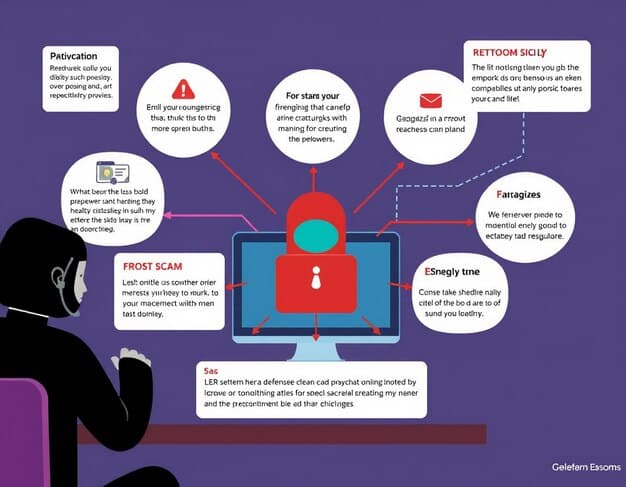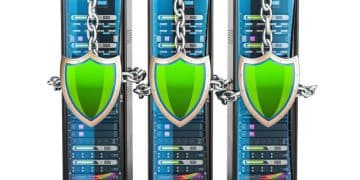Protect Remote Workers: 5 Steps Against Phishing Attacks

Phishing attacks targeting remote workers pose a significant cybersecurity threat; implementing robust defenses, including employee training, strong password policies, multi-factor authentication, software updates, and email security measures, is crucial to safeguard your company’s data.
The rise of remote work has created new opportunities for cybercriminals, with phishing attacks targeting remote workers becoming increasingly prevalent. These attacks can compromise sensitive company data, disrupt operations, and damage your reputation. It’s more important than ever to protect your company.
Understanding the Growing Threat of Phishing Attacks on Remote Workers
Remote work has expanded the digital perimeter of many organizations, creating new vulnerabilities for cyberattacks. Understanding the specific threats faced by remote workers is the first step in building a strong defense against phishing attempts.
Phishing attacks are evolving in sophistication, and remote workers are particularly vulnerable due to factors like increased reliance on personal devices and Wi-Fi networks, distractions at home, and potentially weaker security protocols compared to a traditional office environment.
Why Remote Workers Are Prime Targets
Remote workers often operate outside the protective umbrella of a corporate network. This makes them more susceptible to various phishing tactics.
- Home Networks: Home networks may lack the robust security measures found in corporate environments, making them easier to compromise.
- Personal Devices: Using personal devices for work increases the risk of malware infections and data breaches.
- Distractions: The home environment can be full of distractions, leading to lapses in judgment and increased susceptibility to phishing scams.
The Evolving Tactics of Phishers
Cybercriminals are constantly refining their phishing techniques to bypass security measures and trick unsuspecting users. Here are some common tactics:
Spear Phishing: This involves targeting specific individuals with personalized emails that appear to be from a trusted source, such as a colleague or client.
Whaling: This targets high-profile individuals, such as CEOs or CFOs, with the aim of gaining access to sensitive information or financial resources.
Business Email Compromise (BEC): This involves impersonating a company executive to trick employees into transferring funds or divulging confidential data.
In conclusion, the growing threat of phishing attacks on remote workers requires a proactive and multi-layered approach to cybersecurity. By understanding the specific vulnerabilities and tactics employed by cybercriminals, organizations can implement effective strategies to protect their data and systems.

Step 1: Educating Remote Workers Through Security Awareness Training
One of the most effective ways to combat phishing attacks targeting remote workers is through comprehensive security awareness training. Employees need to be able to identify and respond appropriately to phishing attempts.
Security awareness training should be an ongoing process, not a one-time event. Regular training sessions and reminders can help reinforce best practices and keep employees vigilant.
Key Components of Effective Training
A successful security awareness program should cover a range of topics related to phishing and other cybersecurity threats.
- Identifying Phishing Emails: Teach employees how to recognize common red flags, such as suspicious sender addresses, grammatical errors, and urgent requests for information.
- Safe Browsing Practices: Educate employees on how to avoid malicious websites and download files from trusted sources only.
- Password Security: Emphasize the importance of using strong, unique passwords and avoiding password reuse.
In addition to formal training sessions, consider using simulated phishing attacks to test employees’ awareness and identify areas for improvement. These simulations can provide valuable insights into your organization’s vulnerabilities and help you tailor your training program accordingly.
In conclusion, educating remote workers through security awareness training is a critical step in protecting your organization from phishing attacks. A comprehensive and ongoing training program can empower employees to become the first line of defense against cyber threats.
Step 2: Implementing Strong Password Policies and Multi-Factor Authentication (MFA)
Strong passwords and multi-factor authentication (MFA) are essential security measures for protecting against phishing attacks targeting remote workers. Passwords are the first line of defense, and MFA adds an extra layer of security.
Weak or compromised passwords can give cybercriminals easy access to sensitive data. MFA requires users to provide multiple forms of authentication, making it much harder for attackers to gain unauthorized access.
Creating Strong Password Policies
A strong password policy should include the following guidelines:
- Password Length: Require passwords to be at least 12 characters long.
- Password Complexity: Enforce the use of a combination of uppercase and lowercase letters, numbers, and symbols.
- Password Rotation: Encourage or require employees to change their passwords regularly.
The Power of Multi-Factor Authentication
MFA adds an extra layer of security by requiring users to provide a second form of authentication, such as a code sent to their mobile device or a biometric scan.
MFA can significantly reduce the risk of account compromise, even if a password is stolen or phished. It’s a highly effective way to protect against unauthorized access.
In conclusion, implementing strong password policies and multi-factor authentication is a crucial step in securing remote workers and protecting your organization from phishing attacks. These measures can significantly reduce the risk of account compromise and data breaches.
Step 3: Ensuring Regular Software Updates and Patch Management
Regular software updates and patch management are critical for maintaining a secure IT environment and protecting against phishing attacks targeting remote workers. Software vulnerabilities can be exploited by cybercriminals to gain access to systems and data.
Software vendors regularly release updates and patches to address known vulnerabilities. Applying these updates in a timely manner is essential for closing security gaps and preventing attacks.
Why Software Updates Matter
Software updates often include security patches that fix known vulnerabilities. Failing to apply these updates can leave your systems exposed to attack.
Outdated software is a prime target for cybercriminals. They actively search for systems with known vulnerabilities that can be easily exploited.
Implementing Effective Patch Management
An effective patch management process should include the following steps:
- Inventory: Maintain an accurate inventory of all software and devices used by remote workers.
- Monitoring: Monitor software vendors’ websites and security news sources for announcements of new updates and patches.
- Testing: Test updates in a non-production environment before deploying them to all systems.

In conclusion, ensuring regular software updates and patch management is a critical component of a comprehensive cybersecurity strategy for remote workers. By staying on top of software updates, you can reduce the risk of exploitation and protect your organization from phishing attacks and other cyber threats.
Step 4: Deploying Advanced Email Security Solutions
Email is a primary vector for phishing attacks targeting remote workers. Deploying advanced email security solutions is essential for detecting and blocking malicious emails before they reach employees’ inboxes.
Traditional email security measures, such as spam filters, may not be enough to protect against sophisticated phishing attacks. Advanced solutions use a variety of techniques to identify and block malicious emails, including:
Techniques Used by Advanced Email Security
- Anti-Phishing: These solutions use machine learning and other advanced techniques to identify and block phishing emails.
- Anti-Malware: These solutions scan emails for malicious attachments and links.
- Sandboxing: This involves running suspicious emails in a safe, isolated environment to analyze their behavior and identify any malicious activity.
Furthermore, consider implementing Domain-based Message Authentication, Reporting & Conformance (DMARC) to prevent email spoofing and phishing attacks that use your domain name.
Deploying advanced email security solutions can significantly reduce the risk of phishing attacks and protect your remote workforce from cyber threats.
Step 5: Establishing Incident Response Plan
Despite best efforts, phishing attacks targeting remote workers can sometimes succeed. Having an incident response plan in place is crucial for minimizing the damage and restoring normal operations.
An incident response plan outlines the steps to be taken in the event of a security breach. It should include clear roles and responsibilities, as well as procedures for containing the breach, investigating the incident, and recovering data and systems.
Key Components of an Incident Response Plan
Every organization should have a fully and well-prepared Incident Response Plan, including these components:
- Detection: Establish procedures for detecting and reporting phishing incidents.
- Containment: Implement measures to contain the breach and prevent further damage.
- Investigation: Conduct a thorough investigation to determine the scope of the incident and identify the root cause.
- Recovery: Restore affected systems and data from backups.
Regularly test and update your incident response plan to ensure it remains effective. Conduct tabletop exercises to simulate different types of security incidents and identify areas for improvement.
In conclusion, establishing an incident response plan is a critical step in protecting your organization from the impact of phishing attacks and other cyber threats. A well-defined and regularly tested plan can help you minimize the damage and restore normal operations quickly and efficiently.
| Key Point | Brief Description |
|---|---|
| 🚨 Training Programs | Educate employees to recognize and avoid phishing tactics. |
| 🔑 Password Security | Implement rigorous password policies with MFA for added security. |
| 🛡️ Software Updates | Regularly update software to patch vulnerabilities. |
| 📧 Email Security | Use advanced solutions to filter malicious emails. |
Frequently Asked Questions (FAQ)
▼
Phishing is a cyberattack where criminals impersonate legitimate entities via email or messages to steal sensitive information. Remote workers are particularly vulnerable due to less secure home networks and distractions.
▼
MFA adds an extra layer of security beyond passwords, requiring a second verification method. This significantly reduces the risk of unauthorized access, even if a password is compromised.
▼
Security awareness training educates employees on how to recognize phishing emails and malicious links. Regular training reinforces safe practices and keeps employees vigilant against evolving threats.
▼
An incident response plan should include procedures for detection, containment, investigation, and recovery. It defines the steps to take in case of a security breach to minimize damage and restore operations.
▼
Software updates often include security patches that address known vulnerabilities. Applying these updates promptly helps close security gaps and prevent cybercriminals from exploiting weaknesses in your system.
Conclusion
Protecting remote workers from phishing attacks targeting remote workers requires a multi-faceted approach that includes employee education, robust security measures, and a proactive incident response plan. By implementing these five steps, organizations can significantly reduce their risk and safeguard their valuable data.





